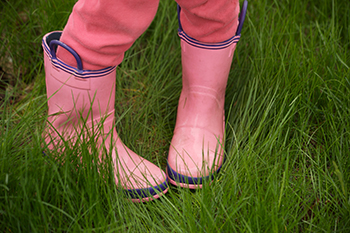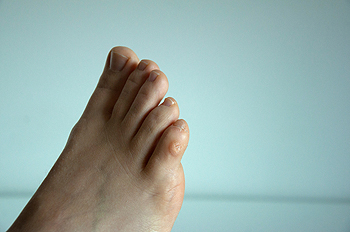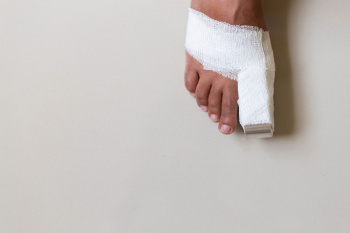Connect With Us
Blog
Items filtered by date: April 2024
In-toeing and Out-toeing in Children
 In-toeing and out-toeing are gait abnormalities seen in children, where the feet point inward or outward, respectively, when walking. In-toeing, often called pigeon-toed, is usually caused by a slight rotation in the shinbone or thigh bone, or a curve in the foot. Out-toeing is less common and often occurs in older children. It can result from conditions like femoral retroversion, where the thigh bone is rotated outward, or from external tibial torsion, involving the outward rotation of the shinbone. Many cases of in-toeing and out-toeing resolve naturally as children grow and their musculoskeletal system matures. Treatment typically involves monitoring the child's growth and development rather than immediate intervention. However, in cases where the condition persists or causes significant walking difficulties, discomfort, or tripping, a podiatrist can offer treatment. It may include specific exercises, orthotics to correct foot positioning, or, in rare instances, surgical options to realign the bones. Regular podiatric check-ups ensure that the child's walking pattern is developing normally and any necessary adjustments are made to promote optimal gait mechanics. If your child is exhibiting abnormal gait patterns, it is suggested that you schedule an appointment with a podiatrist for evaluation.
In-toeing and out-toeing are gait abnormalities seen in children, where the feet point inward or outward, respectively, when walking. In-toeing, often called pigeon-toed, is usually caused by a slight rotation in the shinbone or thigh bone, or a curve in the foot. Out-toeing is less common and often occurs in older children. It can result from conditions like femoral retroversion, where the thigh bone is rotated outward, or from external tibial torsion, involving the outward rotation of the shinbone. Many cases of in-toeing and out-toeing resolve naturally as children grow and their musculoskeletal system matures. Treatment typically involves monitoring the child's growth and development rather than immediate intervention. However, in cases where the condition persists or causes significant walking difficulties, discomfort, or tripping, a podiatrist can offer treatment. It may include specific exercises, orthotics to correct foot positioning, or, in rare instances, surgical options to realign the bones. Regular podiatric check-ups ensure that the child's walking pattern is developing normally and any necessary adjustments are made to promote optimal gait mechanics. If your child is exhibiting abnormal gait patterns, it is suggested that you schedule an appointment with a podiatrist for evaluation.
Making sure that your children maintain good foot health is very important as they grow. If you have any questions, contact Carrie Frame, DPM of West Virginia Foot & Ankle. Our doctor can provide the care you need to keep you pain-free and on your feet.
Keeping Children's Feet Healthy
Having healthy feet during childhood can help prevent medical problems later in life, namely in the back and legs. As children grow, their feet require different types of care. Here are some things to consider...
Although babies do not walk yet, it is still very important to take care of their feet.
Avoid putting tight shoes or socks on his or her feet.
Allow the baby to stretch and kick his or her feet to feel comfortable.
As a toddler, kids are now on the move and begin to develop differently. At this age, toddlers are getting a feel for walking, so don’t be alarmed if your toddler is unsteady or ‘walks funny’.
As your child gets older, it is important to teach them how to take care of their feet.
Show them proper hygiene to prevent infections such as fungus.
Be watchful for any pain or injury.
Have all injuries checked by a doctor as soon as possible.
Comfortable, protective shoes should always be worn, especially at play.
If you have any questions please feel free to contact our office located in Charleston, WV . We offer the newest diagnostic and treatment technologies for all your foot and ankle needs.
Types and Causes of Foot Corns

Corns on the feet are small, yet bothersome, skin formations that can cause significant pain if left untreated. Foot corns, which are composed of layers of dead skin cells, typically appear as thick, circular, raised areas of skin. They commonly develop on, near, or between the toes, below the toenail bed, or on the sole of the feet. The three primary types of foot corns are hard corns, soft corns, and seed corns. Regardless of their type, foot corns can cause discomfort, pain, and a burning sensation, particularly when wearing shoes or walking barefoot. Foot corns develop from excessive pressure or friction on the foot. Causes include wearing tight or ill-fitting shoes, prolonged standing, and walking or running barefoot. It's a good idea to address foot corns promptly and effectively to prevent complications. A podiatrist can offer personalized treatment options, including professional corn removal techniques and recommendations for footwear modifications. If you are experiencing the discomfort of corns on the foot, it is suggested that you schedule an appointment with a podiatrist to determine the type of corn and its proper treatment.
Corns can make walking very painful and should be treated immediately. If you have questions regarding your feet and ankles, contact Carrie Frame, DPM of West Virginia Foot & Ankle. Our doctor will treat your foot and ankle needs.
Corns: What Are They? And How Do You Get Rid of Them?
Corns are thickened areas on the skin that can become painful. They are caused by excessive pressure and friction on the skin. Corns press into the deeper layers of the skin and are usually round in shape.
Ways to Prevent Corns
There are many ways to get rid of painful corns such as:
- Wearing properly fitting shoes that have been measured by a professional
- Wearing shoes that are not sharply pointed or have high heels
- Wearing only shoes that offer support
Treating Corns
Although most corns slowly disappear when the friction or pressure stops, this isn’t always the case. Consult with your podiatrist to determine the best treatment option for your case of corns.
If you have any questions please feel free to contact our office located in Charleston, WV . We offer the newest diagnostic and treatment technologies for all your foot and ankle needs.
Removing a Bone Spur on the Big Toe

A surgical procedure aimed at relieving pain from bone spurs on the top of the big toe is called a cheilectomy. The pain is the result of arthritis that also causes stiffness in the big toe, termed hallux rigidus. Typically considered after non-surgical interventions, a cheilectomy involves the careful removal of bone spurs to alleviate discomfort and improve range of motion. Whether performed under general or local anesthesia, the procedure usually allows for a same-day operation. Following surgery, treatment often starts with gentle toe movements and stretching exercises to prevent stiffness. The recovery period typically spans six to eight weeks. While individual recovery time may vary, the primary goal of restoring function and alleviating pain are the focus. If you have persistent pain and limited mobility in your big toe, it is suggested that you schedule an appointment with a podiatrist for an exam, diagnosis, and personalized treatment plan, which may include surgery.
Foot surgery is sometimes necessary to treat a foot ailment. To learn more, contact Carrie Frame, DPM of West Virginia Foot & Ankle. Our doctor will assist you with all of your foot and ankle needs.
When Is Surgery Necessary?
Foot and ankle surgery is generally reserved for cases in which less invasive, conservative procedures have failed to alleviate the problem. Some of the cases in which surgery may be necessary include:
- Removing foot deformities like bunions and bone spurs
- Severe arthritis that has caused bone issues
- Cosmetic reconstruction
What Types of Surgery Are There?
The type of surgery you receive will depend on the nature of the problem you have. Some of the possible surgeries include:
- Bunionectomy for painful bunions
- Surgical fusion for realignment of bones
- Neuropathy decompression surgery to treat nerve damage
Benefits of Surgery
Although surgery is usually a last resort, it can provide more complete pain relief compared to non-surgical methods and may allow you to finally resume full activity.
Surgical techniques have also become increasingly sophisticated. Techniques like endoscopic surgery allow for smaller incisions and faster recovery times.
If you have any questions please feel free to contact our office located in Charleston, WV . We offer the newest diagnostic and treatment technologies for all your foot and ankle needs.
See Your Podiatrist Regularly If You Work On Your Feet
Persistent Heel Pain Due to Plantar Fasciitis
 Plantar fasciitis, a leading cause of heel pain, occurs when the thick band of tissue that runs along the bottom of your foot and connects the heel bone to the toes becomes inflamed. A large number of plantar fasciitis patients experience persistent heel pain. Treatment for this condition often goes beyond rest, and pain relief measures to include strength exercises specifically designed to alleviate stubborn heel pain. These exercises aim to strengthen the muscles surrounding the foot and ankle, improving support for the plantar fascia and reducing the strain on it. A podiatrist may recommend targeted exercises not only to help relieve the immediate discomfort in the heels but also to prevent future episodes of pain. Incorporating these strength exercises into a comprehensive treatment plan means patients are addressing the root causes of plantar fasciitis. If you experience persistent heel pain from plantar fasciitis, it is suggested that you consult a podiatrist for a personalized treatment plan, which may include performing specific stretches.
Plantar fasciitis, a leading cause of heel pain, occurs when the thick band of tissue that runs along the bottom of your foot and connects the heel bone to the toes becomes inflamed. A large number of plantar fasciitis patients experience persistent heel pain. Treatment for this condition often goes beyond rest, and pain relief measures to include strength exercises specifically designed to alleviate stubborn heel pain. These exercises aim to strengthen the muscles surrounding the foot and ankle, improving support for the plantar fascia and reducing the strain on it. A podiatrist may recommend targeted exercises not only to help relieve the immediate discomfort in the heels but also to prevent future episodes of pain. Incorporating these strength exercises into a comprehensive treatment plan means patients are addressing the root causes of plantar fasciitis. If you experience persistent heel pain from plantar fasciitis, it is suggested that you consult a podiatrist for a personalized treatment plan, which may include performing specific stretches.
Many people suffer from bouts of heel pain. For more information, contact Carrie Frame, DPM of West Virginia Foot & Ankle. Our doctor can provide the care you need to keep you pain-free and on your feet.
Causes of Heel Pain
Heel pain is often associated with plantar fasciitis. The plantar fascia is a band of tissues that extends along the bottom of the foot. A rip or tear in this ligament can cause inflammation of the tissue.
Achilles tendonitis is another cause of heel pain. Inflammation of the Achilles tendon will cause pain from fractures and muscle tearing. Lack of flexibility is also another symptom.
Heel spurs are another cause of pain. When the tissues of the plantar fascia undergo a great deal of stress, it can lead to ligament separation from the heel bone, causing heel spurs.
Why Might Heel Pain Occur?
- Wearing ill-fitting shoes
- Wearing non-supportive shoes
- Weight change
- Excessive running
Treatments
Heel pain should be treated as soon as possible for immediate results. Keeping your feet in a stress-free environment will help. If you suffer from Achilles tendonitis or plantar fasciitis, applying ice will reduce the swelling. Stretching before an exercise like running will help the muscles. Using all these tips will help make heel pain a condition of the past.
If you have any questions please contact our office located in Charleston, WV . We offer the newest diagnostic and treatment technologies for all your foot and ankle needs.
The Prevalence of Bunions
 Bunions, characterized by a bony bump that forms at the base of the big toe, affect a significant portion of the population. This deformity arises when the big toe begins to lean toward the second toe, causing the structure of the foot to change and result in a bump at the big toe joint. Factors contributing to bunion development include genetic predisposition, footwear choices, and certain foot structures. More women than men have bunions, due to wearing narrow, tight-fitting shoes and high heels that place undue pressure on the forefoot. However, anyone can develop bunions, and they are increasingly observed across all age groups, from teenagers to the elderly. The widespread nature of this condition shows the importance of recognizing early symptoms and seeking appropriate treatment. A podiatrist, or foot doctor, has the specialized knowledge of the foot to properly treat and prevent bunions. It is suggested you schedule an appointment with a podiatrist if you have a bunion to prevent its progression.
Bunions, characterized by a bony bump that forms at the base of the big toe, affect a significant portion of the population. This deformity arises when the big toe begins to lean toward the second toe, causing the structure of the foot to change and result in a bump at the big toe joint. Factors contributing to bunion development include genetic predisposition, footwear choices, and certain foot structures. More women than men have bunions, due to wearing narrow, tight-fitting shoes and high heels that place undue pressure on the forefoot. However, anyone can develop bunions, and they are increasingly observed across all age groups, from teenagers to the elderly. The widespread nature of this condition shows the importance of recognizing early symptoms and seeking appropriate treatment. A podiatrist, or foot doctor, has the specialized knowledge of the foot to properly treat and prevent bunions. It is suggested you schedule an appointment with a podiatrist if you have a bunion to prevent its progression.
If you are suffering from bunions, contact Carrie Frame, DPM of West Virginia Foot & Ankle. Our doctor can provide the care you need to keep you pain-free and on your feet.
What Is a Bunion?
A bunion is formed of swollen tissue or an enlargement of boney growth, usually located at the base joint of the toe that connects to the foot. The swelling occurs due to the bones in the big toe shifting inward, which impacts the other toes of the foot. This causes the area around the base of the big toe to become inflamed and painful.
Why Do Bunions Form?
Genetics – Susceptibility to bunions are often hereditary
Stress on the feet – Poorly fitted and uncomfortable footwear that places stress on feet, such as heels, can worsen existing bunions
How Are Bunions Diagnosed?
Doctors often perform two tests – blood tests and x-rays – when trying to diagnose bunions, especially in the early stages of development. Blood tests help determine if the foot pain is being caused by something else, such as arthritis, while x-rays provide a clear picture of your bone structure to your doctor.
How Are Bunions Treated?
- Refrain from wearing heels or similar shoes that cause discomfort
- Select wider shoes that can provide more comfort and reduce pain
- Anti-inflammatory and pain management drugs
- Orthotics or foot inserts
- Surgery
If you have any questions, please feel free to contact our office located in Charleston, WV . We offer the newest diagnostic and treatment technologies for all your foot care needs.

